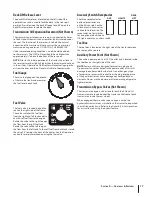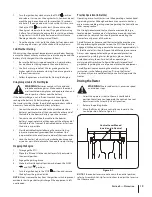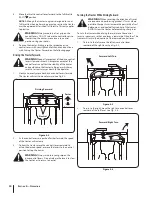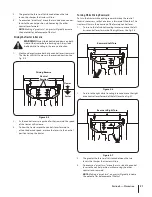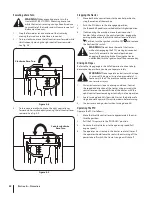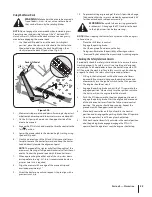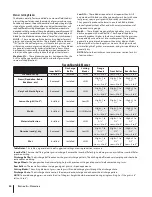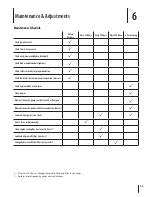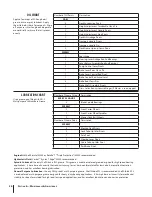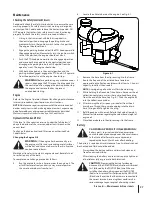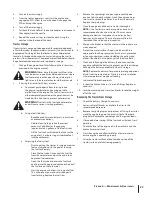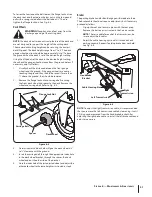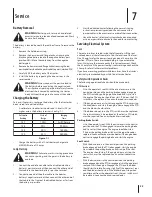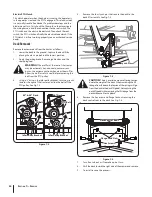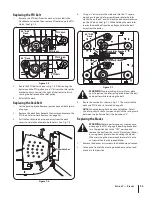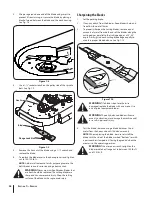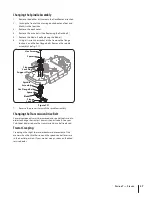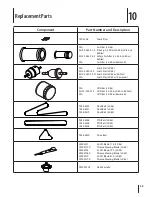
S
ection
5— o
peration
24
Mower Cutting Blades
The blades normally “factory installed” on a mower afford the best
grass cutting performance on the majority of grasses and mowing
conditions; however, there will be occasions whereby the grass type,
stage of grass growth, soil conditions, and weather conditions will
require different cutting blade types. Since the mower decks are
designed so that over-lap of the cutting blades generally exceed 1.5”,
there is no need for orientation of one cutting blade to an adjacent
blade (i.e., the blades do not need to be “timed” nor synchronized).
Hi-lift
— These are generally the best cutting blades for most
grasses and mowing conditions. These blades will provide extra
“lift” for the thinner leaf grasses, will handle lush grasses, and
will provide maximum grass and debris discharge. These blades
are generally required for material collection systems. More
horsepower is required for these blades when compared to
others, and they generally produce the highest noise levels.
Medium-lift
— These blades require less horsepower than the
hi-lift, and they generally work well in wider leaf grasses and
some mulch applications.
Low-lift
— These blades require less horsepower than hi-lift
and medium-lift blades, and they generally work best with wide
leaf grasses, sparse grass growth, and sandy soil conditions.
They generally produce the lowest noise levels. Bahia blades
are configured without offset, and with a maximum amount of
sharpened cutting edge.
Mulch
— These blades are generally designed for use in cutting
decks equipped with mulch baffles. The shape of the blade
generally produces higher turbulence in order that the grass can
be repeatedly cut and re-cut into smaller pieces. These blades
generally require more horsepower than other blades. Mulch
blades work best when the grasses are cut at the highest levels,
minimal lengths of grasses are removed, and grass conditions are
generally dry.
NOTE:
Refer to the attachment and accessories section for a list
of part numbers.
Reconfigurable Mower
Inner Baffle
Discharge
Baffle
Cutting
Blades
Gauge
Wheels
Front Roller
Rear Rollers
Standard set-up
Installed
Installed
Hi-lift
Low = 3 to 5”
Low = 3 to 5”
Low = 3 to 5”
Stems (Dandelion, Bahia,
Buckhorn, etc.)
Removed
Installed
Hi-lift
High = 1 to
2-1⁄2”
Low = 3 to 5”
High = 1 to
2-1⁄2”
Low = 3 to 5”
High = 1 to
2-1⁄2”
Low = 3 to 5”
Very Lush &/or tall grass
Removed
Installed
Hi-lift
High = 1 to
2-1⁄2”
Low = 3 to 5”
High = 1 to
2-1⁄2”
Low = 3 to 5”
High = 1 to
2-1⁄2”
Low = 3 to 5”
Low cut height (1 to 2”)
Installed
Installed
Low-lift
High = 1 to
2-1⁄2”
High = 1 to
2-1⁄2”
High = 1 to
2-1⁄2”
Mulch
Installed
Removed
Hi-lift/Mulch
High = 1 to
2-1⁄2”
Low = 3 to 5”
High = 1 to
2-1⁄2”
Low = 3 to 5”
High = 1 to
2-1⁄2”
Low = 3 to 5”
Material collection
Installed
Installed
Hi-lift
High = 1 to
2-1⁄2”
Low = 3 to 5”
High = 1 to
2-1⁄2”
Low = 3 to 5”
High = 1 to
2-1⁄2”
Low = 3 to 5”
Abrasive (sandy), dry
Removed
Installed
Low-lift
High = 1 to
2-1⁄2”
Low = 3 to 5”
High = 1 to
2-1⁄2”
Low = 3 to 5”
High = 1 to
2-1⁄2”
Low = 3 to 5”
Wet
Installed
Installed
Hi-lift
High = 1 to
2-1⁄2”
Low = 3 to 5”
High = 1 to
2-1⁄2”
Low = 3 to 5”
High = 1 to
2-1⁄2”
Low = 3 to 5”
Table Notes:
This table is a general outline of suggested settings, mowing conditions may vary.
Inner Baffle:
The inner baffle regulates grass discharge. Remove the inner baffle for high-volume grass and install the inner baffle for
precision cutting.
Discharge Baffle:
The discharge baffle enhances the grass discharge pattern. The discharge baffle reduces clumping and should be
removed for mulching.
Gauge Wheels:
The gauge wheels reduce scalping, help with precison cutting and reduce turf defacement during turns.
Rear Rollers:
The rear rollers reduce scalping and gives grass a striped appearance.
Cutting Blades:
The cutting blades cut grass, create grass lift and discharge grass through the discharge chute.
Discharge Chute:
The discharge chute controls the mower deck discharge and enhances the discharge pattern
NOTE:
To avoid damaging grass, no more than 1⁄3 of the grass height should be removed during a single cutting (i.e. if the grass is 6”
tall, cut it to 4”).








